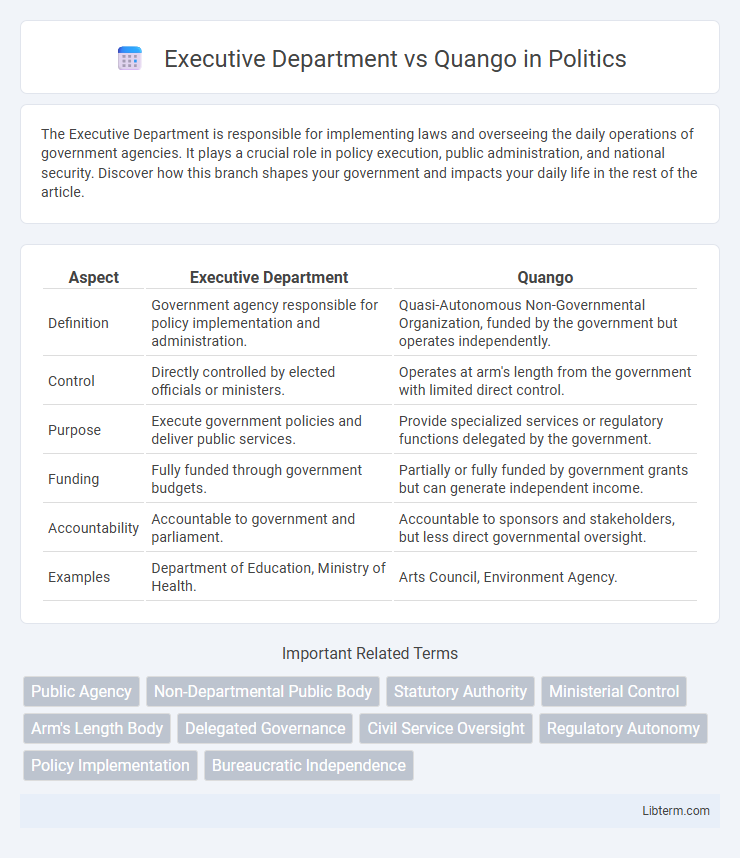The Executive Department is responsible for implementing laws and overseeing the daily operations of government agencies. It plays a crucial role in policy execution, public administration, and national security. Discover how this branch shapes your government and impacts your daily life in the rest of the article.
Table of Comparison
| Aspect | Executive Department | Quango |
|---|---|---|
| Definition | Government agency responsible for policy implementation and administration. | Quasi-Autonomous Non-Governmental Organization, funded by the government but operates independently. |
| Control | Directly controlled by elected officials or ministers. | Operates at arm's length from the government with limited direct control. |
| Purpose | Execute government policies and deliver public services. | Provide specialized services or regulatory functions delegated by the government. |
| Funding | Fully funded through government budgets. | Partially or fully funded by government grants but can generate independent income. |
| Accountability | Accountable to government and parliament. | Accountable to sponsors and stakeholders, but less direct governmental oversight. |
| Examples | Department of Education, Ministry of Health. | Arts Council, Environment Agency. |
Introduction: Understanding Executive Departments and Quangos
Executive departments are core units of government responsible for implementing public policies and managing state functions, typically led by appointed officials or elected ministers. Quangos, or quasi-autonomous non-governmental organizations, operate with government funding and oversight but maintain independent management, often tasked with specialized regulatory or advisory roles. Understanding the distinct governance, accountability, and operational frameworks of executive departments and quangos clarifies their complementary roles in public administration.
Definition of Executive Departments
Executive Departments are primary units of the federal government responsible for implementing laws and managing public policies within specific areas such as defense, education, and health. These departments are headed by appointed secretaries who serve as members of the President's Cabinet, ensuring coordination between the executive branch and legislative directives. In contrast, Quangos (Quasi-Autonomous Non-Governmental Organizations) operate independently from direct governmental control, often tasked with specialist regulatory or service delivery functions.
Definition of Quangos
Quangos, or Quasi-Autonomous Non-Governmental Organizations, are semi-independent bodies funded by the government to perform specific administrative, regulatory, or advisory functions. These entities operate at arm's length from ministerial departments within the Executive Department, providing specialized expertise and reducing direct political control. Quangos often manage public services, regulate industries, or offer policy advice while maintaining a degree of operational autonomy.
Key Differences Between Executive Departments and Quangos
Executive Departments are government agencies directly controlled by ministers with appointed political leadership, responsible for implementing government policies and delivering public services. Quangos, or quasi-autonomous non-governmental organizations, operate with greater autonomy from direct government control, often funded by the government but managed by independent boards or trustees. The key differences lie in governance structure, accountability mechanisms, and degree of political oversight, with Executive Departments subject to ministerial direction and Quangos enjoying operational independence.
Governance Structures: Executive Departments vs Quangos
Executive departments operate directly under ministerial control within the core government framework, ensuring centralized decision-making and accountability to elected officials. Quangos, or quasi-autonomous non-governmental organizations, function with a degree of independence from ministers while receiving public funding to perform specific regulatory or administrative tasks. This governance structure allows quangos to balance operational autonomy with public oversight, contrasting with the hierarchical, politically driven approach of executive departments.
Accountability and Transparency
Executive Departments operate under direct government control with high levels of accountability and transparency, as they are subject to parliamentary oversight, public reporting, and democratic scrutiny. Quangos (Quasi-Autonomous Non-Governmental Organizations) function with greater operational independence, often leading to less direct accountability and reduced transparency compared to traditional executive agencies. The governance frameworks of Executive Departments ensure clearer responsibility chains, while Quangos require specialized oversight mechanisms to maintain public trust and openness.
Roles and Functions in Public Administration
Executive Departments are core government units responsible for implementing laws, managing public policies, and delivering essential services directly to citizens. Quangos (Quasi-Autonomous Non-Governmental Organizations) operate independently from direct government control, providing specialized regulatory or advisory functions to support public administration. While Executive Departments execute and enforce government decisions, Quangos offer expert guidance, regulatory oversight, or service delivery in niche areas such as health, education, or environmental protection.
Funding and Budgetary Controls
Executive departments receive direct funding from the central government budget, enabling strict parliamentary oversight and control over expenditures and allocations. Quangos, or quasi-autonomous non-governmental organizations, typically obtain funding through a mixture of government grants and independent revenue sources, which often results in less stringent budgetary controls and greater financial autonomy. This distinction affects accountability mechanisms, as executive departments must adhere to formal budgetary procedures, whereas quangos operate with more flexible spending powers under broader governmental guidelines.
Advantages and Disadvantages
Executive Departments offer direct governmental control and accountability, ensuring clear policy implementation but may suffer from bureaucratic inefficiencies and political interference. Quangos, or quasi-autonomous non-governmental organizations, provide specialized expertise and operational flexibility, promoting innovation and responsiveness; however, they risk reduced transparency and diminished public accountability. Balancing these structures impacts administrative effectiveness and democratic oversight in public sector management.
Real-World Examples and Case Studies
Executive departments such as the U.S. Department of State directly implement government policies and are headed by appointed officials, exemplified by Secretary of State Antony Blinken's role in foreign diplomacy. In contrast, Quangos like the UK's Environment Agency operate semi-independently from direct government control, managing specific regulatory functions such as flood risk and environmental protection under delegated authority. Case studies comparing the U.S. Environmental Protection Agency (EPA), an executive agency, with UK Quangos illustrate differences in accountability, funding sources, and operational flexibility within public administration frameworks.
Executive Department Infographic

 libterm.com
libterm.com